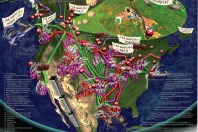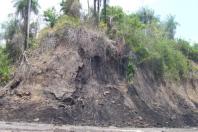Tar Sands Mining Begins in Utah: U.S. Ground Zero For Dirtiest Energy
Tar Sands Mining Begins in Utah: U.S. Ground Zero For Dirtiest Energy
By Tara Lohan, www.hittinghome.org
June 18th, 2013
A few years ago most Americans had never heard of tar sands. Now, thanks to mounting opposition to the Keystone XL pipeline and a recent spill in Arkansas, vocabularies have grown, and so has a movement. Environmentalists have ignited a firestorm of protests over the pipeline, prompting rallies in DC and states across the country, resulting in high-profile arrests and media blitzes.
Keystone XL, which would allow more dirty oil from the environmentally ravished boreal forests of northern Alberta to flow through the U.S., has become a rallying call of sorts, a tangible way for environmentalists and other concerned residents to fight the elusive specter of climate change.
With all the focus on blocking the Obama administration’s approval of Keystone XL, the general public has mostly missed a project plugging along at 8,000 feet atop the Tavaputs Plateau in Eastern Utah (part of the ever-larger Colorado Plateau), and not far from beloved Arches and Canyonlands national parks. This fall a Canadian company named U.S Oil Sands (formerly Earth Energy Resources) leapt another legal hurdle on its multi-year journey to becoming the first large-scale tar sands mine in the U.S. Local and regional activists have been fighting the development for years, but it has somehow missed the national conversation, which is odd because the potential for tar sands and oil shale development in Utah could be massive.
“We don’t want the unconventional fuel industry to gain a foothold on the Colorado Plateau,” said Taylor McKinnon of Grand Canyon Trust. “The U.S. unconventional fuel carbon bomb is bigger than Alberta’s.”
What’s at Stake
Tar sands (also known as oil sands) are rocks that have bitumen (a form of oil) mixed in with sand, clay and water. Tar sands are usually extracted by strip mining an area to remove the rock, then crushing it and using heat, water and chemicals to separate the oil, which is then diluted with other hydrocarbons in order to make it liquid enough to be transported to a refinery. (Sometimes in situ recovery is possible, where steam and chemicals are pumped into underground wells to enable the bitumen to come to the surface.) The process is energy- and water-intensive and the waste massive and dangerous, at least as it has been done in northern Alberta (see photos here).
Utah is the primary location of tar sands in the U.S., but oil shale abounds in Utah, Colorado and Wyoming. Oil shale is similar to tar sands, but when heated the rock releases kerogen, an oil-like substance. The presence of oil shale in the West is no secret—Ute Indians referred to it as “rocks that burn.” What is new, however, is the economics of bringing these unconventional fuels to market and the green light from Washington.
The federal government has approved 132,100 acres of land available for tar sands development in Utah and another 687,000 acres in Utah, Wyoming and Colorado for oil shale. (This is a scaled-back number, thanks to pressure from environmental groups, from what was first proposed in the Bush administration’s 2005 Energy Policy Act.)
U.S. Oil Sands (which did not return interview requests) has already dug its shovel into part of 32,000 acres it has leased in the Tavaputs Plateau. The company started a 200-acre test mine and last October it received sign-off from the state to continue its project following approval from the Water Quality Division. The Division’s director, Walt Baker, believed the company didn’t need a groundwater pollution permit. “He concluded that there is no groundwater to pollute in the project site, around 213 acres in the arid high country between Vernal and Moab,” reported Judy Fahys of the Salt Lake Tribune.
But the environmental group Living Rivers disagrees. Ironically, the site of the test mine is referred to on U.S. Oil Sands’ website as PR Spring, the name of a nearby freshwater spring. Additionally, Jeremy Miller reported for High Country News in July 2012 that the company actually plans to use groundwater from the site to supply the necessary water for the process. As his HCN colleague Stephanie Paige Ogburn wrote in October 2012, “Apparently the groundwater is not too deep to drill into as a water source, but still deep enough to be immune from pollution runoff.”
The company anticipates that it will produce 2,000 barrels of oil a day once it is ramped up to full production. With a seven-year project lifespan, one estimate puts its contribution to the country’s fuel supply at six hours.
And the process won’t be easy. Miller describes what it would look like:
Heavy machinery would scour bitumen from the pit around the clock … The sand and mineral fines remaining after the oil has been removed will be combined, shoved back into the pit and covered with topsoil. But processing expands such wastes by as much as 30 percent. The overflow will be dumped into surrounding ravines—a method starkly reminiscent of Appalachia’s mountaintop coal mining. And the project will create miles of light pollution, illuminating one of the country’s last great “dark” regions.
The company claims the next part of the process makes its version of tar sands mining environmentally friendly by using a citrus-based solvent (although there is much disagreement about this). As Neal Clark of Southern Utah Wilderness Alliance said, “We don’t feel it’s an appropriate use of public lands to vet these unproven technologies that have wide-ranging impacts on air and water quality and habitat to companies that haven’t proven the technology whatsoever.”
But the story doesn’t end with the solvents, as Miller continues:
In order to utilize the solvent, the sands must first be sent through a series of on-site crushers. Hot water is added to the resulting slurry, generating a “froth” of oil, solvent and fine sand particles. This mixture is then passed through a series of separation towers, where the crude oil is isolated. It’s then trucked to refineries in Salt Lake City for processing. Unlike conventional light crude oil, the heavy crude generated from PR Spring—like Canada’s—requires extra, energy-intensive refining steps to remove impurities, such as sulfur and heavy metals, before it can be turned into anything useful.
State and local governments have largely welcomed the project and the county is quite literally paving the way, turning dirt roads into asphalt to speed things along. But opposition of another sort is mounting.
The Fight
“The kids, bless their hearts, don’t want to file lawsuits, they want to stand in front of bulldozers,” said John Weisheit of Living Rivers. “But that’s cool, I support that.”
Weisheit’s organization, along with the environmental law firm Western Resource Advocates, has been leading the charge in litigation to halt tar sands and oil shale development in the region. While they haven’t had a lot of success in court, with the U.S Oil Sands project they have managed to substantially delay development and the company is still searching for investors. Weisheit considers that a win for his side.
In May, Living Rivers, Grand Canyon Trust, Center for Biological Diversity, Sierra Club and Rocky Mountain Wild filed a 60-day notice of intent to sue the BLM. The groups contest that the government agency failed to consider the impact to endangered species that would result from making 800,000 acres of land available to tar sands and oil shale development.
“PR Springs, that is real wilderness up there,” said Weisheit. “There are roadless areas nearby, bald eagles forage up there, and some golden eagles. Sometimes I see so many I can’t believe it.”
The area is home to deer, elk, bear, and the threatened Mexican spotted owl, and it straddles two critical watersheds, the Colorado River (which 30 million people depend on) and the Green River. Nearby Desolation Canyon and its rivers give refuge to three endangered fish species and PR Springs sits just northeast of Moab, Utah, a destination town for recreation enthusiasts and nature lovers, surrounded by national and state parks of prized beauty.
Activist groups like Before It Starts are mounting education camps at the site and doing direct action, but they know PR Springs is just the tip of the iceberg. Another tar sands project at Asphalt Ridge has also been green-lighted near the town of Vernal, Utah, just to the north.
But the largest deposit of tar sands is further south in the state, in an area known as the Tar Sands Triangle, wedged between Canyonlands National Park, Glen Canyon National Recreation Area and the Dirty Devil River Watershed. In essence, it’s prime canyon country.
And tar sands development would be dwarfed by the impacts of oil shale development.
What’s the price of pursuing these unconventional fuels? Well, the BLM said it would “completely displace all other uses of the land.”
Kurt Repanshek, writing in 2010 for National Parks Traveler said, according to the BLM’s own Oil Shale and Tar Sands Draft Programmatic Environmental Impact Statement, that the agency believed its plan (now slightly scaled back) would mean that the air nearby could be:
… contaminated with carbon monoxide, nitrogen oxide, sulfur dioxide and other pollutants, while air close to the site could be contaminated with benzene, toluene and formaldehyde. More than 100,000 acres of wilderness-quality land could be industrialized, construction of reservoirs would alter natural streamflow patterns, hydrocarbons and herbicides could cause ‘chronic or acute toxicity’ in wildlife and habitat for 20 threatened or endangered species could be lost.
And that’s coming from the agency giving the go-ahead.
Grand Canyon Trust’s McKinnon said he doesn’t believe it’s possible that the already-stretched Colorado River Basin could support that level of industry without “unacceptable impacts.”
“The notion of mining climate disaster fuels in a region that is ground zero for global warming impacts is itself alarming,” said McKinnon. “It’s bad land use policy, it’s bad water policy and it’s bad public policy.”
http://www.indypendent.org/2013/06/18/tar-sands-mining-begins-utah-us-gr...


